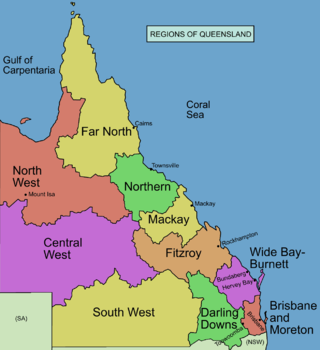
Borroloola is a town in the Northern Territory of Australia. It is located on the McArthur River, about 50 km (31 mi) upstream from the Gulf of Carpentaria.
Garrwa, also spelt Garawa, Gaarwa, or Karawa and also known as Leearrawa, is an Australian Aboriginal language spoken by the Garrwa people of a northern region of the Northern Territory of Australia.
The Wik peoples are an Indigenous Australian group of people from an extensive zone on western Cape York Peninsula in northern Queensland, speaking several different languages. They are from the coastal flood plains bounding the Gulf of Carpentaria lying between Pormpuraaw and Weipa, and inland the forested country drained by the Archer, Kendall and Holroyd rivers. The first ethnographic study of the Wik people was undertaken by the Queensland born anthropologist Ursula McConnel. Her fieldwork focused on groups gathered into the Archer River Mission at what is now known as Aurukun.

The Aboriginal Shire of Doomadgee is a special local government area in North West Queensland, Queensland, Australia. It is managed under a Deed of Grant in Trust under the Local Government Act 2004.

The Gulf Country or North West Queensland is the region of woodland and savanna grassland surrounding the Gulf of Carpentaria in north western Queensland and eastern Northern Territory on the north coast of Australia. The region is also called the Gulf Savannah. The Gulf Country is crossed by the Savannah Way highway.
Pungalina-Seven Emu Sanctuary is a 3060 km2 private protected area in the Northern Territory of Australia. It is managed by the Australian Wildlife Conservancy (AWC) which purchased Pungalina Station in 2009, with some assistance from the Wildlife Australia Fund. It adjoins the Gulf of Carpentaria near the border with Queensland, lying in the Gulf Coastal bioregion. The reserve is bordered by Calvert Hills and Wollogorang Stations to the south and east. The nearest town is Borroloola, 150 km to the west.
Waanyi, also spelt Wanyi, Wanji or Waanji, is an endangered Australian Aboriginal language spoken by the Waanyi people of the lower gulf area of Northern Queensland, Australia. Although earlier thought to be extinct, as of the 2016 Australian census there were 16 speakers of the language. This was down from the recorded peak of 40 in the 2011 Australian census.
Wollogorang Station is a pastoral lease that operates as a cattle station straddling the border the Northern Territory and Queensland.
The Settlement Creek is a creek in the Northern Territory and the state of Queensland, Australia.
The Nicholson River is a river in the Northern Territory and the state of Queensland, Australia.
The Waanyi people, also spelt Wanyi, Wanji, or Waanji, are an Aboriginal Australian people from south of the Gulf of Carpentaria in Queensland and the Northern Territory.
The Yanyuwa people, also spelt Yanuwa, Yanyula and other variations, are an Aboriginal Australian people of the Northern Territory who live in the coastal region inclusive of and opposite to the Sir Edward Pellew Group of Islands in the southern Gulf of Carpentaria.
The Yangkaal, also spelt Yanggal, are an Aboriginal Australian people of area of the Gulf of Carpentaria in the state of Queensland.
The Yukulta people, also spelt Jokula, Jukula, and other variants, and also known as Ganggalidda or Gangalidda, are an Aboriginal Australian people of the state of Queensland.
The Walu were an indigenous Australian people of the Gulf of Carpentaria in the Northern Territory.
The Nggamadi were an indigenous Australian people of the Cape York Peninsula of northern Queensland.
The Pongaponga were an indigenous Australian people of the Northern Territory. They may have been a band of the Ngolokwangga.
The Ngolokwangga are an Aboriginal Australian people of the Northern Territory.
The Marra, formerly sometimes referred to as Mara, are an Aboriginal Australian people of the Northern Territory.
The GanaIanga-Mindibirrina Indigenous Protected Area (IPA) encompases over 10,000 km2 (3,900 sq mi) of the Waanyi Garawa Aboriginal Land Trust area in the southern Gulf of Carpentariain the Northern Territory of Australia, the traditional lands of the Waanyi and Garawa people. The IPA is managed by them through the Waanyi Garawa and Garawa Ranger groups, administered by the Carpentaria Land Council Aboriginal Corporation.